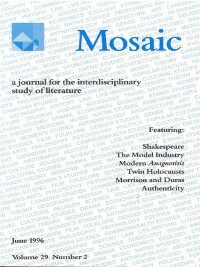Issue 29.2
Overview

General Issue
Published: June 1996
See the issue summary and contents below.
6 essays, totalling 130 pages
$15.00 CAD
The six essays in this general issue of Mosaic broadly focus on how (re)formation happens: be it how print was reforming England with Shakespeare, how the female and model co-formed each other in nineteenth-century painting, or how trauma has informed the subaltern child in the works of Toni Morrison and Marguerite Duras. This issue also contains essays on authenticity, psychology and narrative, and rationalism’s atrocity.
Shakespeare as Media Critic: Communication Theory and HistoriographyDavid Linton A survey of Shakespeare’s plays indicates that he was highly sensitive to the media environment of his age, especially to the impact of the relatively new medium of print and the attendant rise in literacy rates. A close reading of Henry VI, Part II reveals specific, though veiled, references to the manipulation of laws and patents pertaining to the economics of the printing industry. | |
The Social Construction and Deconstruction of the Female Model in 19th-Century FranceMarie Lathers Drawing upon a variety of nineteenth-century French writings, this essay identifies the major types of the artist’s model during this period and traces the shift in preference from the Jewish and Italian to the Parisienne, leading ultimately to the dissipation of the female model into an indistinct group of posing mondaines. These changes are shown to be both an index to and a consequence of changes in the social and cultural climate. | |
Psychological Models for Drama: Ibsen’s Peer Gynt and the ‘Relational Self’Oliver Gerland Dissatisfaction with Freudian theory has prompted development of relational psychologies that stress the self’s ties to others. This essay uses Heinz Kohut’s account of selfhood to identify a psychological rhythm underlying the plot and characters of Ibsen’s Peer Gynt. The essay concludes by suggesting ways that relational psychology can also be correlated with classical philosophy and theories of tragedy. | |
Nabokov’s Genocidal and Nuclear Holocausts in LolitaDouglas Andersen In Lolita Nabokov anticipates Hayden White’s appeal for a history adequate to the agonizing disruptions of modem experience. Humbert Humbert’s complex powers of memory and prophecy humanize the inhumane historical record, mediating between the heart’s “tender nucleus,” the genocide of World War II, and the forces of modern physics. | |
The Politics of Abuse: The Traumatized Child in Toni Morrison and Marguerite DurasLaurie Vickroy Morrison’s The Bluest Eye and Duras’s The Vice-Consul bear witness to the psychic damage that results from living in a colonized situation. Focusing on the traumatized child, both novels attempt to speak for the inarticulate victims of abuse at the same time that they devise narrative strategies to question and address issues of appropriation and complicity. | |
The Ethics of Modernism: The Contribution and Limitations of Charles TaylorAndrew Low This essay examines Charles Taylor’s interpretation of modernism particularly in literature, as a manifestation of “authenticity” and focuses specifically on his argument that such literature is an important source of moral ideas. The essay contends that while authenticity may be a useful critical concept, the connection that Taylor makes between modernism and ethics is questionable. |